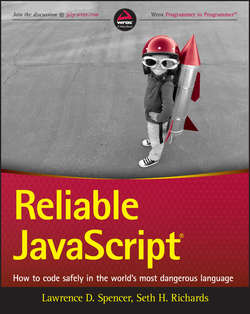Читать книгу Reliable JavaScript - Lawrence Spencer - Страница 12
На сайте Литреса книга снята с продажи.
INTRODUCTION
THIS BOOK'S INTENDED AUDIENCE
ОглавлениеBecause this book isn't a JavaScript primer, we assume you have some JavaScript experience. The following sections outline the attributes of the book's ideal audience.
Developers Who Come to JavaScript from Other Languages
Neither of us started his career as a JavaScript developer, and it's likely you didn't either: JavaScript is a relatively new kid on the block when it comes to large-scale application development.
JavaScript is also quite different from any of the languages that we did have experience in. We come from the comfortable world of the compiled, statically typed language C#.
Our JavaScript got a lot better when we embraced its dynamic nature while maintaining a C# programmer's sense of architecture and discipline.
If you're like us and have a background thinking and programming in a language other than JavaScript, such as C# or Java, this book is for you. Your knowledge of data structures and architecture provide a solid base on which to master JavaScript for large-scale development.
Many of the sections illustrate how language features in C# and Java, such as inheritance and interfaces, correspond to the capabilities in JavaScript. We also highlight many of the major differences between JavaScript and other languages, such as scoping rules and type-coercing equality comparisons. Knowledge of its capabilities and features will improve your ability to think in JavaScript.
Another major focus of this book is how software engineering concepts and practices more commonly associated with C# and Java development, such as design patterns, unit-testing, and test-driven development, may be applied to JavaScript. Sound engineering will temper JavaScript's wild nature, creating reliable and maintainable code.
Developers with Small-Scale JavaScript Experience
In our endeavor to add developers with JavaScript experience to our team, we've encountered many candidates who feel small-scale JavaScript experience, such as input field validation or jQuery element transitions, warrants listing “JavaScript” prominently on a résumé.
In an interview, it doesn't take much time to determine such a candidate has no problem hooking up a button handler, perhaps in the context of an ASP.NET Web Forms application, but would be hard-pressed to create a JavaScript module that has variables that are protected from external manipulation.
As our organization's use of JavaScript has evolved, our definition of what it means to have JavaScript experience has evolved as well. A few years ago, if a developer had a bit of experience with jQuery, we would check our “JavaScript” box with satisfaction.
Now, however, we're looking for a lot more. And we're not alone. It's no longer uncommon for entire applications to be written in JavaScript. In so-called single-page applications (SPAs), the JavaScript code organizes the entire application, bearing vastly more responsibility than the ephemeral click-handlers of the past. In order to participate in the development of a large-scale JavaScript application, developers must know how to use the language in a structured and disciplined way while simultaneously taking advantage of its many unique capabilities and quirks.
Through the examples in this book, we hope to help you, the small-scale JavaScript developer, make it big.
Developers Responsible for Choosing Programming Languages for a New Project
Perhaps you've heard the adage “No one ever gets fired for buying IBM.” The statement reflects the feeling that, when faced with choosing a technology partner for an IT project, it's unlikely that the decision to pick an established, reputable company such as IBM will be second-guessed. The statement implies that IBM is the safe choice. Even if the project experiences cost over-runs, missed deadlines, or complete failure, the choice of IBM is above reproach.
If you're in a position to choose the language or languages used for the development of a new application, you're in the same position as the IT manager choosing a technology partner. There are many tried-and-true programming languages with long histories. For instance, C# and Java, each backed by a large, established technology company, have been used to build both web and desktop applications for over a decade. No one would be fired for choosing C#.
In terms of being a safe choice for a new programming project, especially in the enterprise, JavaScript is decidedly not like C#. JavaScript is not a mature, staid, starched-shirt-wearing programming language. She is young, daring, and free-spirited.
She doesn't have the same long track record of success for large-scale software projects that languages such as C# and Java have. That's not to say that projects using C# and Java are guaranteed to succeed. If a project using one of those languages isn't successful, however, language choice probably wouldn't be included as a factor contributing to failure.
As we mentioned in the previous section, JavaScript makes it all too easy to write disastrous code. This has given her a bit of a reputation, reducing the likelihood you'd want to bring her home to meet mom and dad.
JavaScript's reputation should not automatically exclude her for consideration for projects that could benefit from her strengths. Node.js, a server-side JavaScript engine, is lightweight and highly scalable; perfect for real-time and data-intensive applications. JavaScript may be used to create rich user interfaces in the browser. Client-side frameworks such as Ember and AngularJS may be used to build complete browser-based applications that can help reduce the load on the web server by off-loading presentation logic to the client.
While we can't guarantee it will succeed, the upcoming chapters will show ways to mitigate the risk of choosing JavaScript for your next project by applying the lessons we've learned while working on our own projects.
Success will not happen by accident, especially with JavaScript. It requires a firm grasp of engineering principles, which are the subject of the first chapter.
